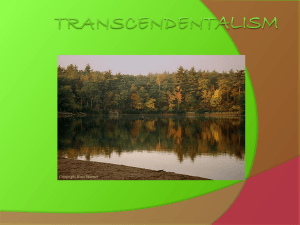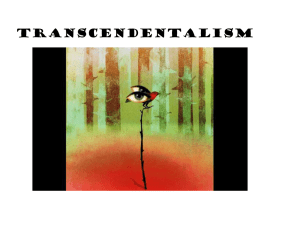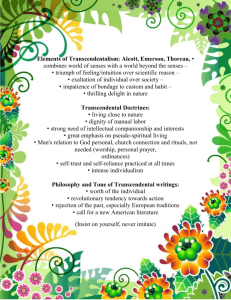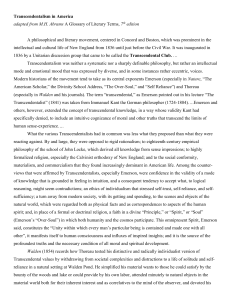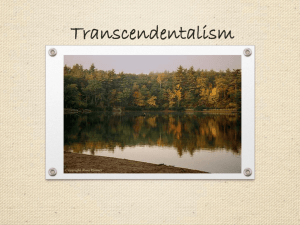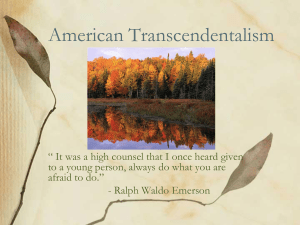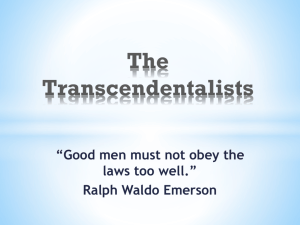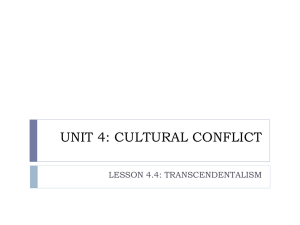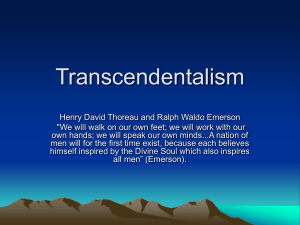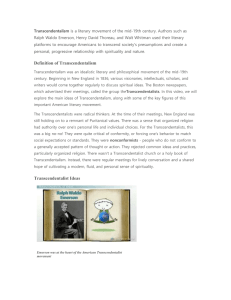File - Coach Roy's AP Classes
advertisement
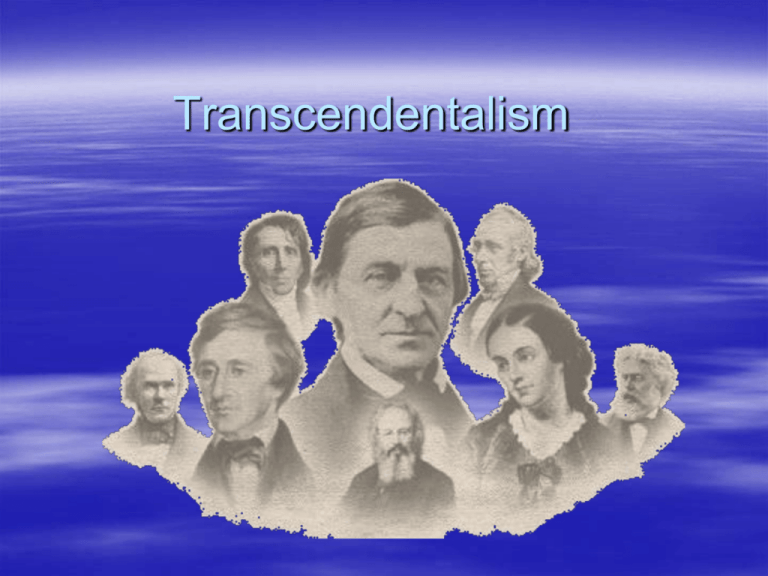
Transcendentalism American transcendentalism was an important movement in philosophy and literature that flourished during the early to middle years of the nineteenth century (about 18361850). It is easier to note its pervasive influence, though, than it is to clarify its doctrines. It began as a reform movement in the Unitarian church. It was based on "a monism holding to the unity of the world and God, and the immanence of God in the world" For the transcendentalists, the soul of each individual is identical with the soul of the world and contains what the world contains. One basic premise is that an individual is the spiritual center of the universe - and in an individual can be found the clue to nature, history and, ultimately, the cosmos itself. It is not a rejection of the existence of God, but a preference to explain an individual and the world in terms of an individual. The basic assumption of transcendentalism is that the intuitive faculty, instead of the rational or sensical, became the means for a conscious union of the individual psyche with the world psyche also known as the Oversoul, life-force, prime mover and God. Ralph Waldo Emerson The structure of the universe literally duplicates the structure of the individual self - all knowledge, therefore, begins with selfknowledge. This is similar to Aristotle's dictum "know thyself." Aristotle Plato Transcendentalists accepted the neoPlatonic conception of nature as a living mystery, full of signs nature is symbolic. Another way to look at transcendentalism is to see it as a struggle to define spirituality and religion in a way that took into account the new understandings the modern age (1830 – 1850) made available. The Enlightenment (18th century) had come to new rational conclusions about the natural world, mostly based on experimentation and logical thinking. The pendulum was swinging, and a more Romantic way of thinking - less rational, more intuitive, more in touch with the senses -- was coming into vogue. Those new rational conclusions had raised important questions, but were no longer enough. Transcendentalism as a movement is rooted in the American past: To Puritanism it owed its pervasive morality and the "doctrine of divine light." It is also similar to the Quaker "inner light." Quaker tapestry panel However, both of these concepts assume acts of God, whereas intuition is an act of an individual. In Unitarianism, deity was reduced to a kind of immanent principle in every person - an individual was the true source of moral light. To Romanticism it owed the concept of nature as a living mystery and not a clockwork universe (deism) which is fixed and permanent. On an American visit, Charles Dickens was told that "whatever was unintelligible would certainly be transcendental“. Edgar Allan Poe instructs a young author to write the Tome Transcendental by using small words but turning them upside down. A Baltimore clergyman noted that "a new philosophy has risen, maintaining that nothing is everything in general, and everything is nothing in particular." The belief that individual virtue and happiness is dependent upon selfrealization depends upon the reconciliation of two universal psychological tendencies: Bust of Emerson a. the expansive or self-transcending tendency - a desire to embrace the whole world - to know and become one with the world. b. the contracting or self-asserting tendency - the desire to withdraw, remain unique and separate an egotistical existence. The Transcendental emphasis on the oneness of individual souls with nature and with God gave dignity and importance to human activity and made possible a belief in the power to effect social change in harmony with God's purposes. To sum all of this up Characteristics of Transcendentalism – Reality is derived through intuition rather than sensory experience Individualism and nonconformity are promoted All living things are connected by a universal soul, or Oversoul Civil disobedience when society (the government) is wrong Focus on spiritual relationships between humanity and nature Belief in a simple life style Optimism Appreciation and respect for nature Emerson was the central and most influential figure among the group of radical thinkers and writers of the 1830s-1850s known as the New England Transcendentalists. A chief event of life is the day in which we have encountered a mind that startled us. -- Ralph Waldo Emerson His Nature, issued anonymously in 1836 was a systematic exposition of Transcendental philosophy. Ralph Waldo Emerson, Nature (1836) "Standing on the bare ground,--my head bathed by the blithe air, and uplifted into infinite space,-all mean egotism vanishes. I become a transparent eye-ball. I am nothing. I see all. The currents of the Universal Being circulate through me; I am part or parcel of God" A subtle chain of countless rings The next unto the farthest brings; The eye reads omens where it goes, And speaks all languages the rose; And, striving to be man, the worm Mounts through all the spires of form. - Ralph Waldo Emerson, Nature, 1836 The movement began with the occasional meetings of a group of friends in Boston and Concord to discuss philosophy, literature, and religion. They were dubbed the Transcendental Club by outsiders because of their discussion of Immanuel Kant's transcendental ideas. Immanuel Kant CONCORD, MASSACHUSETTS Crucible of American political and intellectual history, the town of Concord, Massachusetts was not only the cradle of American independence, but also the spiritual and actual home of the American Transcendentalists. The Old North Bridge over the Concord River as it flows past the Old Manse. The ideas of transcendentalism were eloquently expressed by Henry David Thoreau in his book Walden (1854). The site of Thoreau’s cabin at Walden Pond Thoreau is considered one of the most influential figures in American thought and literature. A supreme individualist, he championed the human spirit against materialism and social conformity. ` He believed a person’s conscience was the best test of what was right, which led to his belief in civil disobedience. Besides Emerson and Thoreau, its most famous members, the club included F. H. Hedge, George Ripley, Bronson Alcott, Margaret Fuller, Theodore Parker, and others. Margaret Fuller
